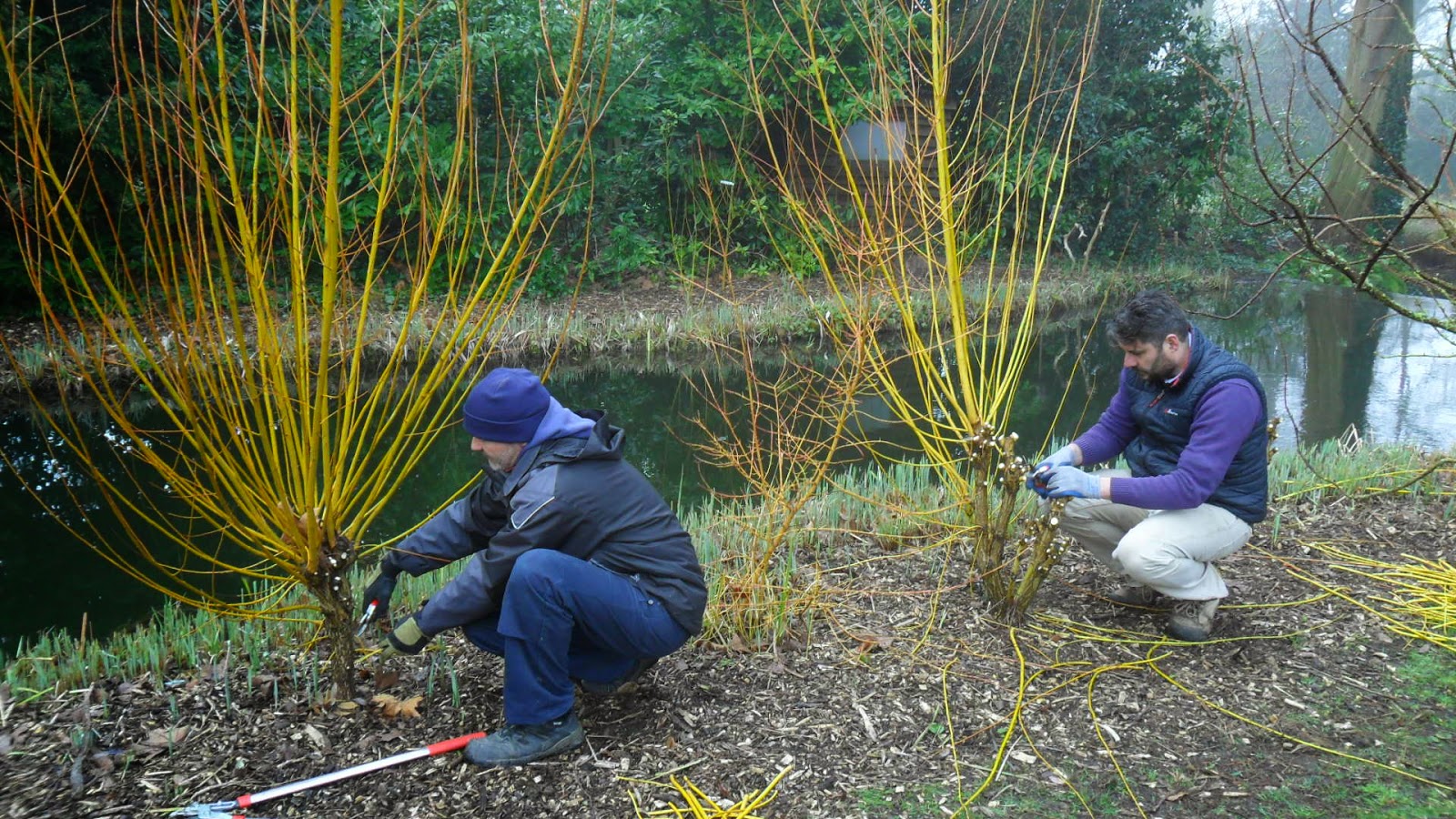Tuesday, 31 March 2015
Disaster For The Waterfowl
Gale force, northwesterly winds battered many parts of the UK today, doing their best to knock the gardeners off their feet as they swept through Oxfordshire. The damage, however, was limited to the island in the lake, blowing one of the two duck houses from its pitch into the lake. When it was retrieved from the water its contents were revealed, a clutch of 24 eggs, a very sad sight to behold, and a disaster for the waterfowl. The Aylesbury duck and a Canada Goose have been spotted by the house fighting over it, so it is unknown as to which one they belong to. Hopefully, as it is still early spring, there is plenty of time to lay another clutch.
Monday, 30 March 2015
Verticutting and Aerating
The quad lawn was heavily scarified last year, see blog entry 8th September 2014 'The Scarifying Of The Quad Lawn Begins', ripping out the thatch that had built up over the previous three years. Today Joss, joined by Callum, began the spring maintenance of the quad, verticutting and aerating. The process of verticutting is less harsh than scarification, penetrating the top layer of turf removing dead grass on the surface rather than reaching deep in to the thatch layer. The aerating makes holes in the turf enabling water and air to reach the roots of the grass.
Friday, 27 March 2015
The Chiffchaff Have Arrived
On a beautiful warm, sunny spring day, the first Chiffchaff has been heard in the college grounds having made the long flight from the Mediterranean and western Africa where they spend the winter. Six days later than last year's arrival date, 21st March, the Chiffchaff was seen at the top of trees at the far end of the broadwalk singing its wonderful song that heralds the arrival of spring and the first of the summer migrants.
Additional Note:
The Chiffchaff was last heard in the gardens 21st September 2015
Thursday, 26 March 2015
Moving Out, Hardening Off And Potting On
 |
| A Full Greenhouse |
 |
| Peach House |
To make room the cuttings that were taken in September, potted up in October and potted on in February, are moved out of the heated greenhouse and in to the colder peach house. Acclimatising these plants to the harsher outdoor conditions is a process called 'hardening off', they will have to ready by the beginning of June when they will be planted outside as part of this year's summer display.
 |
| Space On The Bench Waiting To Be Filled |
 |
| Potting On |
 |
| The Space Filled |
Sufficient room has now been created on the bench for the seedlings, but this won't be empty for long as the pricking out starts next week.
 |
| Ready For The Seedlings |
Wednesday, 25 March 2015
A New Hoggin Path In The Fellow's Garden
Two small deliveries of hoggin arrived today to renovate the gravel path in the Fellow's garden. Six and a half tonnes were dropped by the gate to the garden and transferred in by wheelbarrow. Tipped on to the old path and raked to form a slight camber, a raised center which sheds water to each side, the hoggin was then compacted using a wacker plate. A further delivery is due tomorrow, 10 tonnes in total for the new, improved path.
Tuesday, 24 March 2015
Pruning The Fig (Ficus carica)
 |
| Before |
The Fig, Ficus carica, has not had a hard prune since 'The Return Of Bodge It and Scarper', (Mick and Ali), see blog entry 31st March 2009. Having been lightly pruned over the last 6 years it has now got too large and is in need of some renovation. The fig has been trying to escape from the corner, over hanging its boundary and creating shade on the surrounding grass, not too mention, making it difficult to reach the fruit. Ali was given the task of pruning it, cutting the largest, oldest branches back to a few inches, reducing the height for easy picking, removing branches to improve the shape as well as removing the 'Three D's', dead, diseased and damaged wood. The fig is now away from the boundary of its gravelled corner with plenty of room to grow over the next few years.
 |
| After |
Friday, 20 March 2015
Solar Eclipse 2015
For the first time this century a solar eclipse was seen across the skies of Britain and, as the eclipse started, the clouds parted across central Oxford to reveal the Moon passing between the Sun and the Earth. Here are a few photographs taken by Ali from within the college grounds:
 |
| Eclipse |
 |
| Eclipse reflection in the lake |
 |
| Eclipse reflection |
Thursday, 19 March 2015
Demonstration By Nomix Enviro
Chris Vernon, Area Manager from 'Nomix Enviro' visited the college this morning to give the team a demonstration of their Hand-held Total Droplet Control (TDC) applicators. Currently using Cooper Peglar 15 litre knapsack sprayers to apply herbicides these have become cumbersome and very heavy when spraying large areas,over long periods of time. The Nomix Frontline Compact and Frontline Classic are both lightweight, carrying a load of 750ml and 5 litres respectively. The applicators use the Nomix herbicides that do not require any mixing with water, just herbicide packs that connect directly to them eliminating any risk to the operator from mixing chemicals and protecting the environment by avoiding spillages.
The Nomix TDC is a low volume, targeted herbicide application system that delivers a constant, uniform droplet size and spray pattern of oil-emulsion formulations that stick to the leaf, significantly reducing the risk of run off and virtually eliminating spray drift. Lots of information for the team to think about, thank you Chris for coming in to see us.
Wednesday, 18 March 2015
Willow Weaving A Goose Proof Fence, A Flower, Fish, Dragonfly and An Igloo
The six Scarlet Willow, Salix alba 'Chermesina', planted by the lake in April 2012, see blog entry 17th April 'The Stump Border', are pruned at this time of this year to encourage new yellow-red stems for display next winter, but what to do with the huge amount of willow prunings?
Pruned hard back the willow produces an annual growth of stems of up to 10 foot tall, so for the first time the prunings have been used to create the goose proof fence (usually made with wooden stakes and wire, see blog entry 18th March 2014 'Canada Goose Proof Fence').
 |
| Flower |
To start, some of the long willow prunings, rods, were bent over and their ends pushed into the soil. (It is hoped the ends will not root in to the soil too deeply as the fence will need to be removed when the marginal planting is cut down next January). Simon, Kieron and Ali then continued weaving more willow onto this framework to create a goose proof fence to stop the geese from wandering in to the Provost's garden. Once finished a flower, fish and a dragonfly had also been created, even an igloo play den in the garden!
 |
| Weaving The Dragonfly |
 |
| Dragonfly |
 |
| Fish |
 |
| Goose Proof Fence |
 |
| Igloo (Play Den) |
Try again Kieron, you need to make it bigger and stronger!
Friday, 13 March 2015
Pruning The Salix' Yelverton' For The Return Of Winter Colour
The four Salix 'Yelverton' were planted out in the college gardens on the 28th November 2013, see blog entry 'Salix alba ssp. vitellina Yelverton', to provide rich bronze-red stems in the winter. These colours were seen in their first winter, 2013-14, but during the last winter 2014-15, their second winter, the colour was a much weaker yellow-green.
In order for the rich red-bronze to return Simon made the rather brave decision to prune the trees heavily, removing their top growth, the crown, and shortening all the remaining stems
By the time Simon, Ali and Danny had finished pruning only the trunks remained. This heavy pruning will cause the trees to produce a mass of new growth from the top, new, young bronze-red stems for next winter.
Thursday, 12 March 2015
Silver Maple Or Red Maple?
The gardener's often get asked questions by visitors about the names of plants in the gardens, most of which are answered, but today one was asked which they were unable to give the answer to. The question, the name of a tree with tiny clusters of red/yellow flowers on the branches? This question needed further investigation. A large tree with the flowers very high up but a few were found on the ground. Leaves were also found around the base of the tree giving the Genus in which to look, Maple (Acer), now which species is it? Next to the book 'Trees of North America and Europe' by Roger Phillips and Martyn Rix, full of photographs to refer to, Silver Maple (Acer saccharinum) or Red Maple (Acer rubrum). The question has almost been answered but which of the two Maples is it? The team are still undecided, it may even mean waiting until it is in full leaf and even as far as waiting for the autumn colour. In the mean time they are waiting for the flowers to open completely in the hope that this will give them the answer sooner rather than later.
Lifting, Dividing And Planting Snowdrops
The snowdrops have provided a wonderful display this year but are now going over. The flowers are fading first so it is a good time to lift and divide large clumps and replant them, 'in the green', the best way to establish snowdrops. Large clumps were lifted from the Nelson Street path, an area by the sports field, and taken in trugs for planting in a bare area beneath the canopy of a beech tree on the Nuffield lawn.
 |
| Beneath The Beech Tree (Before) |
The clumps were divided in to smaller pieces, approximately 10 bulbs in each, gently prizing them apart causing as little disturbance as possible.
Holes were then dug, the snowdrops planted in at the same depth as in their previous location, and gently firmed in. A few thousand snowdrops were planted beneath the tree, in addition to a similar amount that had been planted on Tuesday. Watered in, it is hoped that they will establish, creating a wonderful drift of white next year.
 |
| Beneath The Beech Tree (After) |
Subscribe to:
Comments (Atom)



































